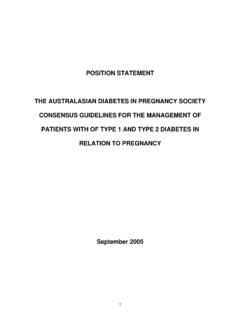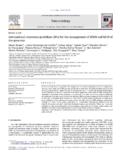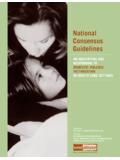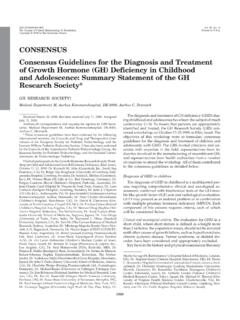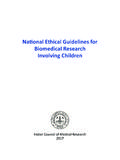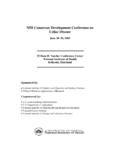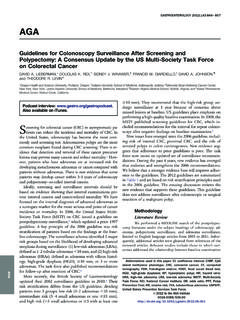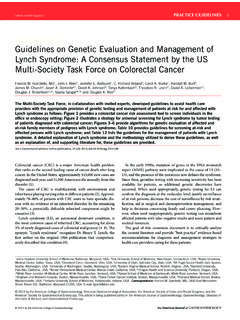Transcription of ADIPS Consensus Guidelines for the Testing and …
1 Page 1 of 8 ADIPS Consensus Guidelines for the Testing and Diagnosis of hyperglycaemia in pregnancy in australia and New Zealand (modified November 2014) Nankervis A, McIntyre HD, Moses R, Ross GP, Callaway L, Porter C, Jeffries W, Boorman C, De Vries B, McElduff A for the Australasian Diabetes in pregnancy Society The Australasian Diabetes in pregnancy Society ( ADIPS ) originally formulated recommendations for the Testing and diagnosis of gestational diabetes mellitus (GDM) in These Guidelines were primarily based on expert opinion. With some local variations, the ADIPS Guidelines have been used since that time. In the light of recent evidence, ADIPS has elected to revise these Guidelines in the current document.
2 Recommendations for future research are summarised at the end of this document. The Hyperglycemia and Adverse pregnancy Outcome study (HAPO) published in 20082 was a large, prospective, blinded, multinational, observational study that examined pregnancy outcomes in 23,316 women whose plasma glucose (PG) levels were fasting and 2-hrs post 75g oral glucose load. This study reported a strong correlation between increasing maternal glucose levels at 24-32 weeks gestation and a range of adverse maternal and fetal outcomes. Subsequent consideration by the International Association of Diabetes and pregnancy Study Groups (IADPSG), with Australasian representation, resulted in the formulation of new Consensus Guidelines for the Testing and diagnosis of These Guidelines have been endorsed by several national organisations and the World Health Organisation (WHO)4.
3 There has been a change in the demographics of women becoming pregnant and an increase in the rate of type 2 diabetes mellitus (DM) in the Australian This has resulted in more women of childbearing age having abnormalities of glucose tolerance, including undiagnosed DM, detected for the first time during pregnancy . The WHO refers to hyperglycaemia in pregnancy with sub-division into DM and GDM. Women with DM are at higher risk of major pregnancy complications and require urgent attention, including evaluation for other complications of undiagnosed diabetes. 1. Recommendations for early Testing for hyperglycaemia in pregnancy for women with risk factor(s) Women, not known to have pre-existing glucose abnormalities, but with risk factors for hyperglycaemia in pregnancy (vide infra) should be tested early in pregnancy .
4 The method of Testing must be based on clinical judgement, local health care policy and possible risk stratification (see section requiring further research). Women deemed at higher risk should ideally have a pregnancy OGTT (POGTT) or a HbA1C Page 2 of 8 Risk factors for hyperglycaemia in pregnancy Previous hyperglycaemia in pregnancy Previously elevated blood glucose level Maternal age 40 years Ethnicity: Asian, Indian subcontinent, Aboriginal, Torres Strait Islander, Pacific Islander, Maori, Middle Eastern, non-white African Family history DM (1st degree relative with diabetes or a sister with hyperglycaemia in pregnancy ) Pre- pregnancy BMI > 30 kg/m2 Previous macrosomia (baby with birth weight > 4500 g or > 90th centile) Polycystic ovarian syndrome Medications.
5 Corticosteroids, antipsychotics Routine Testing for hyperglycaemia in pregnancy All women not previously known to have pre pregnancy diabetes or hyperglycemia in pregnancy should undergo a 75 g POGTT at 24 28 weeks gestation. All women should be tested, as stratification by risk factors is unreliable. The glucose challenge test (GCT) lacks both sensitivity and specificity and is no longer part of the diagnostic algorithm. There is also no need for a 3 day high carbohydrate diet before the POGTT. Recommendations for diagnostic criteria for hyperglycaemia in pregnancy ADIPS has accepted the WHO4 recommendations for the diagnostic classification of hyperglycaemia first detected at any time during pregnancy .
6 These recommendations are: hyperglycaemia first detected at any time during pregnancy should be classified as either: (1) diabetes mellitus in pregnancy or; (2) gestational diabetes mellitus. 1. Diabetes mellitus in pregnancy should be diagnosed by the 2006 WHO criteria for diabetes if one or more of the following criteria are met: (a) Fasting plasma glucose mmol/l ; (b) 2-h plasma glucose mmol/l following a 75 g oral glucose load; Page 3 of 8 (c) a random plasma glucose mmol/l in the presence of diabetes symptoms. 2. The diagnosis of gestational diabetes mellitus at any time during pregnancy should be based on any one of the following values: (a) Fasting plasma glucose mmol/l ; (b) 1-h post 75 g oral glucose load mmol/l*; (c) 2-h post 75 g oral glucose load mmol/l.
7 *there are no established criteria for the diagnosis of diabetes mellitus in pregnancy based on the 1-h post-load value Diabetes in pregnancy may not necessarily be confirmed as diabetes in the postpartum period. Diabetes is more likely to be confirmed in the postpartum period when the hyperglycaemia in pregnancy is diagnosed early and/or the degree of hyperglycaemia is marked. Levels of evidence The diagnostic criteria are in accord with those chosen by the WHO. The 0, 1 and 2 hour values were chosen to identify the same risk of an adverse fetal outcome at each time point. There are 2 large, RCTs (and other intervention studies)6,7,8 which clearly demonstrate the benefits of treatment for both mother and fetus (Level 1 evidence) although the diagnostic criteria used in these studies were not consistent, and are slightly different from the values selected by the WHO and used in these Guidelines .
8 In areas where the rate of undiagnosed type 2 diabetes is thought to be high, or in remote areas where the performance of a POGTT may be logistically difficult, a measurement of HbA1c can be considered. A level of 48mmol/mol ( ) is diagnostic of diabetes outside pregnancy and very likely represents previous undiagnosed type 2 diabetes. There is insufficient evidence to correlate lower levels of HbA1c with lesser degrees of glucose intolerance. 2. Suggested treatment targets in GDM It is recognised that glycaemic targets in the treatment of hyperglycaemia in pregnancy vary between centres and clinicians around australia . This issue is discussed further in the section of this document entitled Areas for further research.
9 Clinician judgement should guide practice in this area, both in the setting of overall glucose targets and the glucose thresholds which would lead to pharmacological treatment of individual women. Page 4 of 8 3. Management in the postpartum period Unless clinically contraindicated, women diagnosed with GDM, and some women with DM, should have a 75g 2-hr OGTT, preferably at 6-12 weeks post-partum, with classification according to the WHO criteria. Women diagnosed with hyperglycaemia in pregnancy should have regular ongoing surveillance as they have an approximate 30% risk of a recurrence of their hyperglycaemia in a subsequent pregnancy9 and a risk of developing type 2 DM ranging from per year10,11 The frequency and nature of this surveillance will depend on future pregnancy plans and the perceived risk of converting to type 2 DM.
10 Women contemplating another pregnancy should have an OGTT annually. Women being tested for the possible development of type 2 DM should have a GTT or a HbA1c every three years with more frequent Testing depending on clinical circumstances12 For women deemed at low risk, a fasting plasma glucose or HbA1C every 1-2 years should be sufficient. 4. Potential impact of the new diagnostic criteria for hyperglycaemia in pregnancy The new recommended diagnostic criteria will increase the prevalence of hyperglycaemia in Using IADPSG / WHO criteria, a prospective study in Wollongong demonstrated an increase from to A post hoc analysis of the HAPO sites in australia demonstrated a prevalence in Brisbane of and in Newcastle of Page 5 of 8 Acknowledgements This second version of the Guidelines has been produced with the assistance of the Royal Australasian College of Obstetrics and Gynaecology (RANZCOG) and the Royal College of Pathologists of australia (RCPA).


